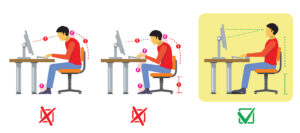These days, although we all know to make an effort to get up and move around, it’s easy to end up sitting for an extended period. Whether it’s working overtime at the office or a movie marathon, sitting and the way you sit can have a significant effect on your back. So, how does the way you sit affect your back muscle? And what can you do about it? Let’s take a look:
The impact sitting has on our spines
So, what is it about sitting that has such an effect on our spines? But first, let’s explore what happens when you sit.
When you’re moving, your spine’s discs contract and expand. This flexibility allows the discs to absorb the pressure in your spinal vertebrae, acting as a shock absorber. Moving like this is vital for a healthy spine, and moving often keeps your spine healthy and more able to move.
However, when you’re sitting, this causes more pressure on your spine. Because of this, your discs get compressed. Compressing your discs often by sitting down a lot can reduce flexibility in your spine. Sitting a lot can also make herniated discs more likely, weaken your back muscles, and make injury a stronger possibility.
You can see how having weak core muscles and a weak back, which frequent sitting causes, means less support for your spine. But on top of this, sitting also tightens your hip flexors. This can restrict blood flow to another set of muscles that support your spine – your gluteal muscles.
By sitting, your shoulders are typically rounded, with your head more forward than usual. Posture like this often causes your spinal ligaments to stretch, increasing wear on discs.
How can I sit better?
You can’t stand up all day. Yet, sometimes, sitting down is necessary to do certain things. And yet, sitting can have several ill health effects on your body. But it doesn’t have to be this way. A few simple changes can give you a better sitting position and much improved spinal health!

Change the height of your chair
If you use a computer chair or office chair, the first thing you did when you got into it was use the levers to adjust it, up and down, forward and back, until you were completely comfortable, right? But have you changed it since then?
If not, it’s time to check: make sure your legs are parallel with the ground and your knees even to your hips. Your feet should be flat – preferably on the floor. If not, place something on the ground so that it can be. Try not to sit cross-legged since this reduces blood flow to your legs. Above all, make sure that you are comfortable!
If you don’t have an office chair, you could try adjusting the position of your chair using cushions, a rolled-up towel, or other objects. You could also use a posture corrector to prevent slipping into a poor posture wherever you sit.
Think about your mouse and keyboard position
You sit and use your mouse and keyboard so much that it’s easy to forget about them. However, taking care to position your input devices more ergonomically can pay off your posture in the long run. For example, to support your wrists, try leaving a little distance between your keyboard and the edge of the desk.
There’s a reason typewriters have raised keyboards – they’re more ergonomic. You may experience wrist strain if you use them for extended periods. So, consider using a wrist rest.
Adjust your monitor or screen
It’s essential to have your monitor or screen in the correct position. After all, you don’t want to twist or look downward to see your screen. You should have your screen directly in front of you and at a comfortable height and distance away. If possible, placing your screen arm’s length away is the best idea, but the main thing is getting your screen at the right height for your neck.
You could use a laptop stand, opening up your laptop so that the keyboard is comfortable to use too. Or, you could place your laptop on boxes and other objects, with another keyboard connected, until the screen is raised to a comfortable height. You could even use an external monitor and adjust it until it is comfortable to use. Finally, you can connect your laptop to your TV.
Take a break!
For the sake of both your fingers and your spine, take regular breaks when sitting for a long time. These breaks don’t have to be extended if you’re on a deadline. Standing up for just a minute or two is ideal for breaking up those long sitting periods and getting your spine working again.
If you find that you forget to take breaks, there is software that can remind you to get up every hour or so. Some software even locks your keyboard and mouse so that breaks are mandatory! You can also set movement reminders or alarms on your phone or smartwatch.
Standing up and walking around every once in a while is all you need to do, but if you want to supercharge your spinal health during your breaks, why not try an exercise snack of some quick stretches? Or, dig out the Swiss ball to work on your core for a while!
With so many people having office jobs and sitting for extended periods, it’s easy to develop a minor problem with your core or spine. Maybe you’re experiencing pain. Or perhaps you just want to prevent things from getting worse. Whatever your goals or needs are, we can help you address them with physiotherapy or one of our physio rehab classes. Book now at MGS Physiotherapy.
